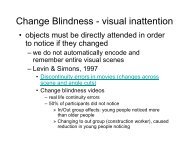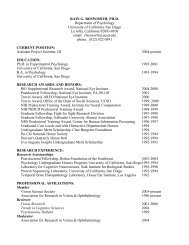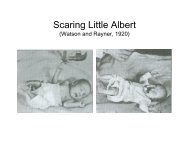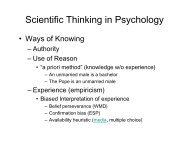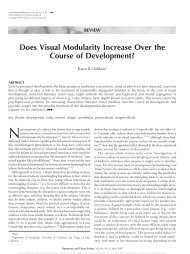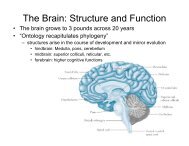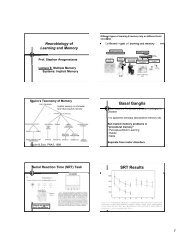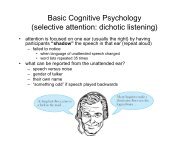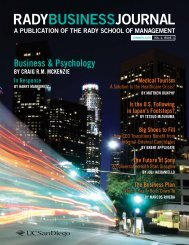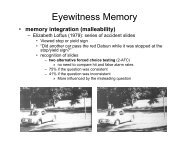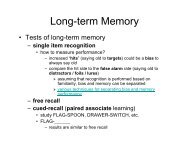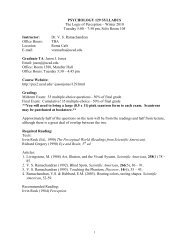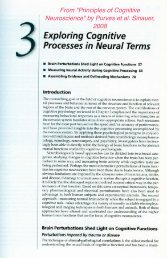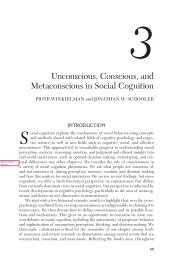Confirmation Bias: A Ubiquitous Phenomenon in Many Guises
Confirmation Bias: A Ubiquitous Phenomenon in Many Guises
Confirmation Bias: A Ubiquitous Phenomenon in Many Guises
You also want an ePaper? Increase the reach of your titles
YUMPU automatically turns print PDFs into web optimized ePapers that Google loves.
216 RAYMOND S. NICKERSON<br />
well do jurors reason? Competence dimensions of<br />
<strong>in</strong>dividual variations <strong>in</strong> a juror reason<strong>in</strong>g task.<br />
Psychological Science, 5, 289-296.<br />
Kuhn, T. S. (1970). The structure of scientific<br />
revolutions (2nd ed). Chicago: University of<br />
Chicago Press.<br />
Kunda, Z. (1990). The case for motivated reason<strong>in</strong>g.<br />
Psychological Bullet<strong>in</strong>, 108, 480-498.<br />
Kunda, Z., & Nisbett, R. E. (1986). The psychometrics<br />
of everyday life. Cognitive Psychology, 18,<br />
195-224.<br />
Lakatos, I. (1976). Proofs and refutations: The logic<br />
of mathematical discovery (J. Worrall & E. Zahar,<br />
Eds.). New York: Cambridge University Press.<br />
Lakatos, I. (1978). Falsification and the methodology<br />
of scientific research programmes. In I. Lakatos<br />
The methodology of scientific research programmes<br />
(J. Worrall & G. Currie, Eds.; pp. 8-101).<br />
New York: Cambridge University Press.<br />
Langer, E. J., & Abelson, R. P. (1974). A patient by<br />
any other name... : Cl<strong>in</strong>ical group differences <strong>in</strong><br />
label<strong>in</strong>g bias. Journal of Consult<strong>in</strong>g and Cl<strong>in</strong>ical<br />
Psychology, 42, 4-9.<br />
Laplace, P. S. (1956). Concern<strong>in</strong>g probability. In J. R.<br />
Newman (Ed.), The world of mathematics (Vol. 2;<br />
pp. 1325-1333). New York: Simon and Schuster.<br />
(Orig<strong>in</strong>al work published 1814)<br />
Lawson, R. (1968). Order of presentation as a factor<br />
<strong>in</strong> jury persuasion. Kentucky Law Journal, 56,<br />
523-555.<br />
Lefford, A. (1946). The <strong>in</strong>fluence of emotional<br />
subject matter on logical reason<strong>in</strong>g. Journal of<br />
General Psychology, 34, 127-151.<br />
LeGrand, H. E. (1988). Drift<strong>in</strong>g cont<strong>in</strong>ents and<br />
shift<strong>in</strong>g theories: The modern revolution <strong>in</strong> geology<br />
and scientific change. Cambridge, England: Cambridge<br />
University Press.<br />
Legrenzi, P. (1970). Relations between language and<br />
reason<strong>in</strong>g about deductive rules. In G. B. Flores<br />
d'Arcais & W. J. M. Levelt (Eds.), Advances <strong>in</strong><br />
psychologistics (pp. 322-333). Amsterdam: North<br />
Holland.<br />
Lenski, G. E., & Leggett, J. C. (1960). Caste, class,<br />
and deference <strong>in</strong> the research <strong>in</strong>terview. American<br />
Journal of Sociology, 65, 463^4-67.<br />
Lev<strong>in</strong>e, M. (1970). Human discrim<strong>in</strong>ation learn<strong>in</strong>g.<br />
The subset-sampl<strong>in</strong>g assumption. Psychological<br />
Bullet<strong>in</strong>, 74, 397-404.<br />
Liberman, N., & Klar, Y. (1996). Hypothesis test<strong>in</strong>g<br />
<strong>in</strong> Wason's selection task: Social exchange cheat<strong>in</strong>g<br />
detection or task understand<strong>in</strong>g. Cognition, 58,<br />
127-156.<br />
Lichtenste<strong>in</strong>, S., & Fischhoff, B. (1977). Do those<br />
who know more also know more about how much<br />
they know? Organizational Behavior and Human<br />
Performance, 20, 159-183.<br />
Lichtenste<strong>in</strong>, S., Fischhoff, B., & Phillips, L. D.<br />
(1977). Calibration of probabilities: The state of<br />
the art. In H. Jungermann & G. de Zeeuw (Eds.),<br />
Decision mak<strong>in</strong>g and change <strong>in</strong> human affairs (pp.<br />
275-324). Dordrecht, Netherlands: Reidel.<br />
L<strong>in</strong>gle, J. H., & Ostrom, T. M. (1981). Pr<strong>in</strong>ciples of<br />
memory and cognition <strong>in</strong> attitude formation. In<br />
R. E. Petty, T. M. Ostrom, & T. C. Brock (Eds.),<br />
Cognitive responses <strong>in</strong> persuasive communications:<br />
A text <strong>in</strong> attitude change (pp. 399-420).<br />
Hillsdale, NJ: Erlbaum.<br />
Loftus, E. F, & Wagenaar, W. A. (1988). Lawyers'<br />
predictions of success. Jurimetrics Journal, 28,<br />
437^53.<br />
Lord, C. G., Lepper, M. R., & Preston, E. (1984).<br />
Consider<strong>in</strong>g the opposite: A corrective strategy for<br />
social judgment. Journal of Personality and Social<br />
Psychology, 47, 1231-1243.<br />
Lord, C, Ross, L., & Lepper, M. R. (1979). <strong>Bias</strong>ed<br />
assimilation and attitude polarization: The effects<br />
of prior theories on subsequently considered<br />
evidence. Journal of Personality and Social<br />
Psychology, 37, 2098-2109.<br />
Luch<strong>in</strong>s, A. S. (1942). Mechanization <strong>in</strong> problem<br />
solv<strong>in</strong>g: The effect of E<strong>in</strong>stellung. Psychological<br />
Monographs, 54, 1-95.<br />
Luch<strong>in</strong>s, A. S. (1957). Experimental attempts to<br />
m<strong>in</strong>imize the impact of first impressions. In C. I.<br />
Hovland (Ed.), The order of presentation <strong>in</strong><br />
persuasion. New Haven, CT: Yale University<br />
Press.<br />
Lusted, L. B. (1977). A study of the efficacy of<br />
diagnostic reaiologic procedures: F<strong>in</strong>al report on<br />
diagnostic efficacy. Chicago: Efficacy Study Committee<br />
of the American College of Radiology.<br />
Lycan, W. C. (1988). Judgment and justification. New<br />
York: Cambridge University Press.<br />
Maclntyre, A. (1988). Whose justice? Which rationality?<br />
Notre Dame, IN: University of Notre Dame Press.<br />
Mackay, C. (1932). Extraord<strong>in</strong>ary popular delusions<br />
and the madness of crowds (2nd ed.). Boston: Page.<br />
(Orig<strong>in</strong>al second edition published 1852)<br />
Mahoney, M. J. (1976). Scientist as subject: The<br />
psychological imperative. Cambridge, MA: Ball<strong>in</strong>ger.<br />
Mahoney, M. J. (1977). Publication prejudices.<br />
Cognitive Therapy and Research, 1, 161-175.<br />
Manktelow, K. I., & Over, D. E. (1990). Deontic<br />
thought and the selection task. In K. J. Gilhooly,<br />
M. T. G. Keane, R. H. Logic, & G. Erdos. (Eds.),<br />
L<strong>in</strong>es of th<strong>in</strong>k<strong>in</strong>g (Vol. 1). London: Wiley.<br />
Manktelow, K. I., & Over, D. E. (1991). Social roles<br />
and utilities <strong>in</strong> reason<strong>in</strong>g with deontic conditionals.<br />
Cognition, 39, 85-105.<br />
Manktelow, K. I., & Over, D. E. (1992). Utility and<br />
deontic reason<strong>in</strong>g: Some comments on Johnson-<br />
Laird and Byrne. Cognition, 43, 183-188.<br />
Markovits, H., & Savary, F. (1992). Pragmatic<br />
schemas and the selection task. Quarterly Journal<br />
of Experimental Psychology, 45A, 133-148.



